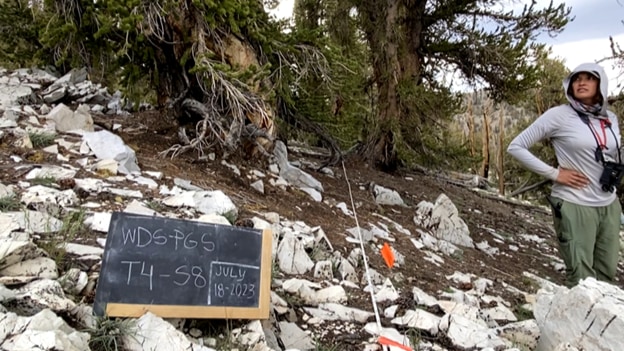
¿Alguna vez te has preguntado qué tipos de especies de flores viven a 14,252 pies de altura? (A bi-lingual look at the White Mountains)
by Diana Martinez, 2023 GLORIA Great Basin Fellow. Diana offers Spanish-English publication translation services. To inquire please email her at diamar@umich.edu
Las Montañas Blancas de California son una de las áreas de hábitat más unicas. Las montañas blancas albergan los árboles vivos más antiguos del mundo: los antiguos pinos ‘bristlecone’ Pinus Longaeva. Este ecosistema único tiene algunas de las condiciones climáticas más duras en las que las especies han encontrado formas de sobrevivir en los últimos años.
Este verano pasado, fui parte de una hermosa experiencia como parte del becario GLORIA Great Basin Peak. Nuestra estación de campo fue en Crooked Creek y tuvimos la oportunidad de viajar para obtener datos sobre especies de flores en la montaña Campito y Patriarch Grove.
Durante mis estudios universitarios, tomé una clase de botánica en Cal Poly Humboldt; Tenía curiosidad por conocer la diversidad de especies como las plantas vasculares, briofitas, líquenes, hongos y algas y sus respectivos niveles y familias de estructura. Lo que más me sorprendió fue mirar debajo un microscopio observavanos los tejidos del interior de una. Desde esa experiencia en la clase, siempre he tenido curiosidad por aprender sobre la variedad de flores.
Este verano, en las Montañas Blancas, traje las habilidades que aprendí en mi clase de botánica. Al llegar a las Montañas Blancas a principios de julio, todavía había mucha nieve en la cima de los picos, pero en la elevación más baja cerca de la montaña Campito, la nieve se había derretido significativamente y pude presenciar las diversas especies de flores. También adquirí nuevas habilidades en botánica y aprendí de expertos y científicos apasionados por la botánica, la ciencia y el aprendizaje.
Durante nuestros días de observacion, fui testigo de la polinización de las polillas por primera vez; Aunque siempre había leído sobre ello, nunca lo había visto hasta entonces. También encontré mi flor favorita, Fleabane Erigeron Clokeyi de Clokey.
Fleabane Erigeron Clokeyi de Clokey es una hierba perenne originaria de California y también se encuentra en otras partes del oeste de América del Norte. Erigeron Clokeyi es originario del matorral de salvia de Nevada y del extremo oriental de California. Los tallos erguidos, peludos y no ramificados, sostienen una inflorescencia de una sola cabeza floral de aproximadamente un centímetro (0,4 pulgadas) de ancho. La cabeza tiene un centro de floretes de disco de color amarillo dorado y una franja de, a veces, hasta 55 floretes radiales de color púrpura muy claro a medio (ocasionalmente blanco o rosado), que generalmente son reflejos (inclinados hacia afuera del centro).
Cada flor es extraordinaria, como Fleabane Erigeron Clokeyi de Clokey. Las flores crean polen en la parte superior del estambre, que es la antera, donde se forman los granos de polen. Las flores ofrecen polen, una fuente esencial de proteínas y néctar. Las diferentes formas de flores, patrones de color y aromas son parte de los esfuerzos de la planta para atraer polinizadores, tal como la polilla que vi polinizando una flor durante la recopilación de datos. Además, las flores promueven un ecosistema y una biodiversidad saludables.
Durante mi estancia en las Montañas Blancas, vi la diversa biodiversidad de especies de flores que viven en este hábitat y noté lo especiales que son estas montañas. Aunque las condiciones climáticas han cambiado con el tiempo y continúan cambiando, es fundamental seguir investigando los cambios en la biodiversidad de la zona.
La próxima vez que visite las Montañas Blancas, observe el área mientras camina e imagine cómo este entorno ha cambiado a lo largo de un milenio hasta nuestros días. Recuerde sentir curiosidad por este hermoso ecosistema, hogar de diversas especies de líquenes, rocas, tierra, árboles, polinizadores, aves y nosotros, los humanos.
English follows…
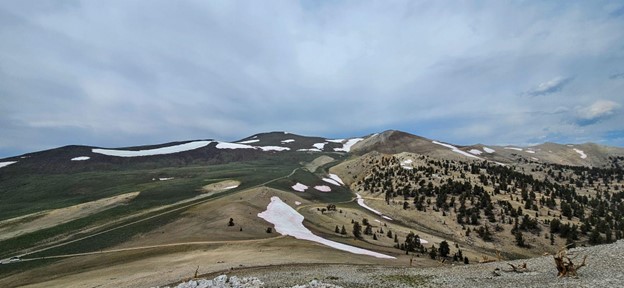
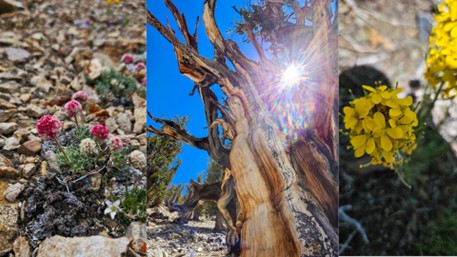
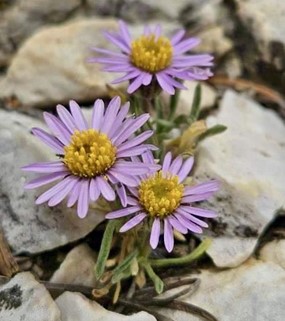
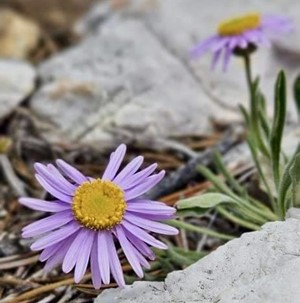
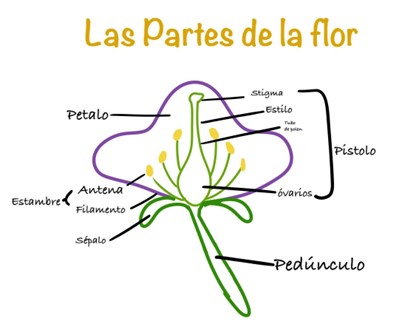
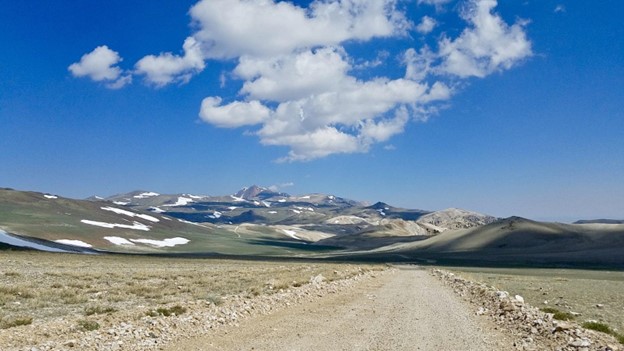
Have you ever wondered what types of flower species live at 14,252 ft?
The White Mountains of California are one of the most unique habitat ranges. The white mountains are home to the oldest living trees in the world: the Ancient Bristlecone Pines Pinus longaeva. This unique ecosystem has some of the harshest weather conditions in which species have found ways to survive over the past few years.
This past summer I was part of a beautiful field experience as part of the GLORIA Great Basin Peak fellow. Our field station was at Crooked Creek field station, and we had the opportunity to travel to collect data on flower species in Campito Mountain and Patriarch Grove.
During my undergraduate studies, I took a botany class at Cal Poly Humboldt; I was curious to learn about the diversity of plant species regarding vascular plants, bryophytes, lichens, fungi, and algae and their respective levels and families. I was most amazed when we did plant cross-sections and looked under a microscope. Since that class experience, I have always been eager to learn more about flowers in California.
In the White Mountains this summer, I brought the skills I learned in my botany class. Coming up to the White Mountains in early July, there was still so much snow at the peak of the peaks, but at the lower elevation near Campito Mountain, the snow had significantly melted, and I could witness the diverse species of flowers. I also gained new botany skills and learned from experts and scientists passionate about botany, science, and learning.
During our field days, I witnessed moth pollination for the first time; although I had always read about it, I had never seen it until then. I also found my favorite flower, Clokey’s Fleabane Erigeron Clokeyi.
Clokey’s Fleabane Erigeron Clokeyi is a perennial herb that is native to California and also found elsewhere in western North America. Erigeron Clokeyi is native to the sage scrub of Nevada and far eastern California.
The hairy, unbranching upright stems hold an inflorescence of a single flower head about a centimeter (0.4 inches) wide. The head has a center of golden yellow disc florets and a fringe of sometimes as many as 55 very light to medium purple (occasionally white or pink) ray florets, which are usually reflexed (bent away from the center).
Every flower is extraordinary, just like Clokey’s Fleabane Erigeron Clokeyi. Flowers create pollen at the top of the stamen, which is the anther, where pollen grains are made. Flowers offer pollen, an essential source of protein and nectar. The different flower shapes, color patterns, and scents are all part of the plant’s efforts to attract pollinators, just like the moth I saw pollinating a flower during data collection. Additionally, flowers promote a healthy ecosystem and biodiversity.
During my time in the White Mountains, I saw the diverse biodiversity of flower species living in this habitat and noticed how special these mountains are. Although the weather conditions have changed over time and continue to change, it is essential to continue to research the changes in the area’s biodiversity.
Next time you visit the White Mountains, observe the area as you walk and imagine how this environment has changed over a millennia to our present time. Remember to be curious about this beautiful ecosystem, home to diverse species from lichen, rocks, soil, trees, pollinators, birds, and us humans.

En la foto (de izquierda a derecha) Diana Martinez, Selena Vengco, y Marife Minaya, todos los voluntarios por 2023 GLORIA Great Basin. Pictured (left to right) Diana Martinez, Selena Vengco, and Marife Minyaya, all were GLORIA Great Basin 2023 volunteers.